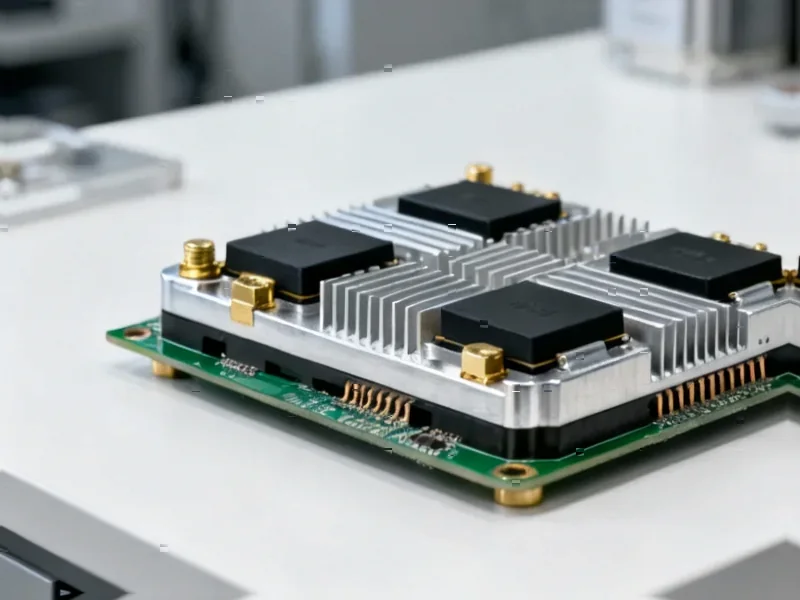According to Engineer Live, Toshiba Electronics Europe has launched six new products featuring the DTMOSVI 600V series of N-channel MOSFET chips in 4-pin TO-247-4L(X) packages. The TKxxxZ60Z1 devices reduce switching loss and target applications including data center servers, industrial switched-mode power supplies, and photovoltaic power conditioners. The new series achieves a 13% reduction in drain-source on-resistance per unit area and a 52% improvement in the critical RDS(ON) x Qgd figure of merit compared to previous-generation DTMOSIV-H series. The four-pin package design specifically addresses switching-induced inductance issues that plague traditional three-pin packages, enabling faster switching speeds and higher efficiency. This strategic product expansion represents Toshiba’s latest move in the competitive power semiconductor landscape.
The $50 Billion Energy Efficiency Imperative
Toshiba’s timing with these MOSFET releases aligns perfectly with global energy efficiency mandates that are creating unprecedented demand for high-performance power semiconductors. The data center market alone represents a massive opportunity, with global electricity consumption from data centers projected to exceed 1,000 TWh annually by 2026 according to International Energy Agency data. Each percentage point improvement in power conversion efficiency translates to millions in operational cost savings for hyperscale operators. Similarly, the solar inverter market is experiencing explosive growth as countries accelerate renewable energy deployments, creating demand for more efficient power conditioning systems that maximize energy harvest from photovoltaic installations.
Strategic Positioning Against Infineon and STMicroelectronics
Toshiba is directly challenging dominant players like Infineon and STMicroelectronics in the premium power MOSFET segment. The 52% improvement in the RDS(ON) x Qgd figure of merit represents a significant technological leap that could help Toshiba regain market share lost to European competitors in recent years. The four-pin TO-247 package specifically targets applications where switching frequency and efficiency are paramount, allowing Toshiba to compete on performance rather than price in a market increasingly segmented by application requirements. This move follows Toshiba’s broader semiconductor strategy to focus on high-margin, application-specific power devices rather than competing in commoditized segments.
Revenue Implications and Manufacturing Economics
The financial impact of this product launch extends beyond simple unit sales. Power semiconductors targeting data center and industrial applications typically command premium pricing with margins 15-20% higher than consumer-grade components. More importantly, these devices create design-in opportunities that can lead to multi-year supply agreements with major OEMs in server power supplies, industrial equipment, and renewable energy systems. The 13% improvement in RDS(ON) per unit area also has significant manufacturing cost implications, as it enables either higher performance from the same silicon area or equivalent performance from smaller die sizes, improving yield and reducing production costs per unit.
Why This Launch Matters Now
This product introduction comes at a critical inflection point in power electronics. The global push toward electrification and renewable energy is creating supply constraints in high-performance power semiconductors, particularly for 600V-rated devices used in three-phase industrial systems and solar applications. Simultaneously, data center operators are facing increasing pressure to improve power usage effectiveness (PUE) metrics as artificial intelligence workloads drive power densities to unprecedented levels. Toshiba’s timing allows them to capitalize on both trends while the semiconductor industry undergoes significant restructuring and consolidation in the power management segment.
The Road Ahead for Power Semiconductors
Looking forward, Toshiba’s DTMOSVI technology represents more than just an incremental product improvement—it signals the company’s commitment to remaining relevant in the rapidly evolving power semiconductor landscape. The four-pin package adoption indicates where the industry is heading: toward solutions that address system-level performance challenges rather than just component-level specifications. As switching frequencies continue to increase in next-generation power supplies and inverters, package parasitics and gate drive integrity will become increasingly critical differentiators. Toshiba’s approach suggests they’re preparing for a future where power density and efficiency requirements will push conventional packaging technologies to their limits.




